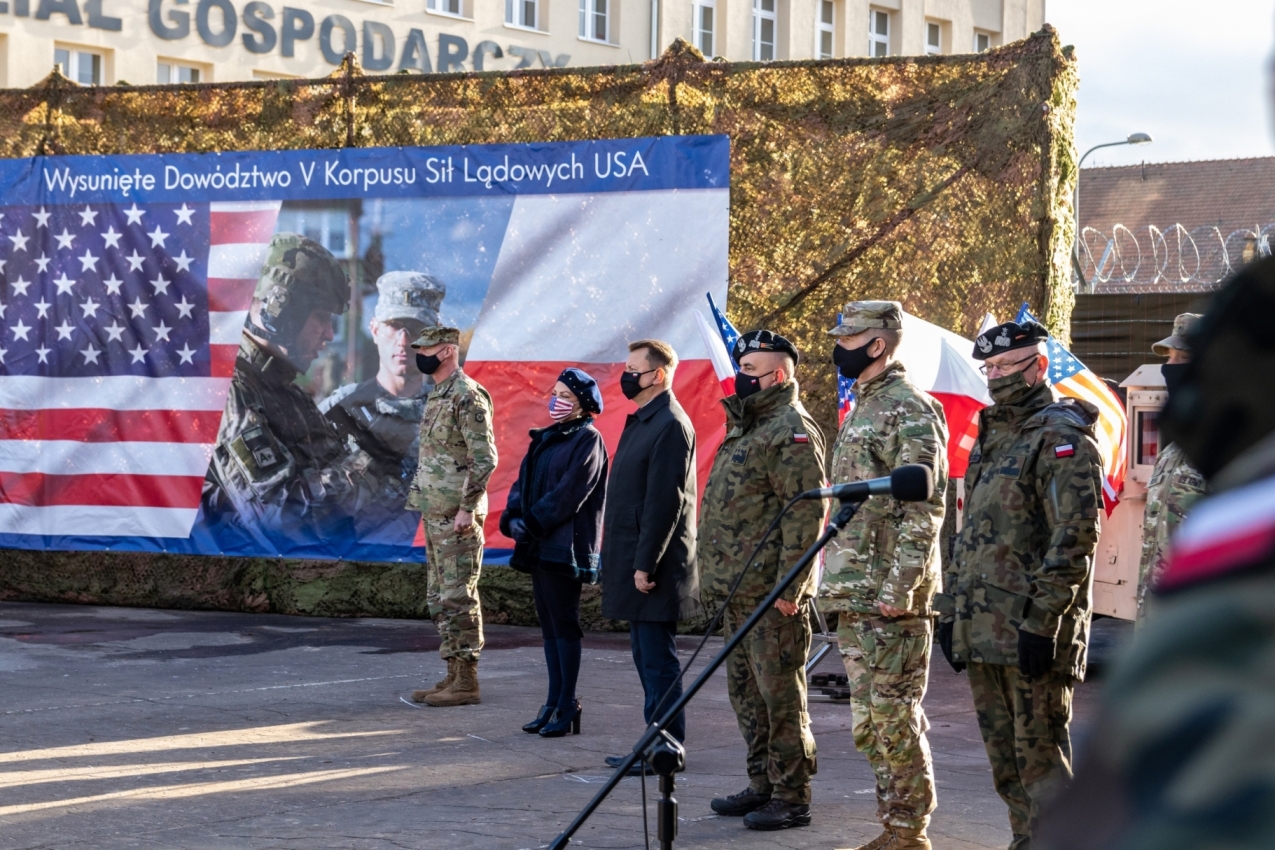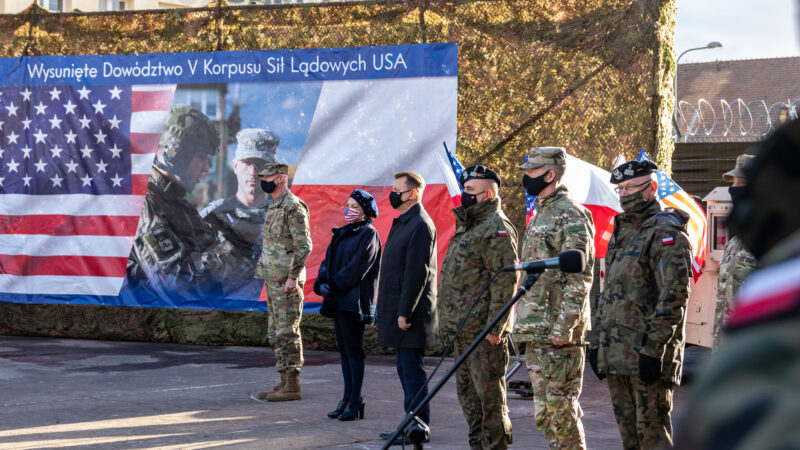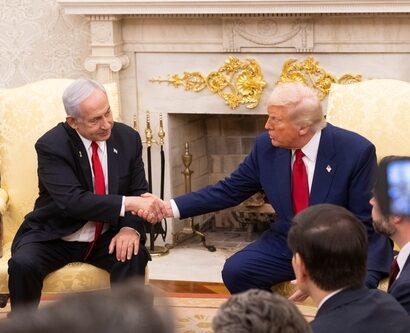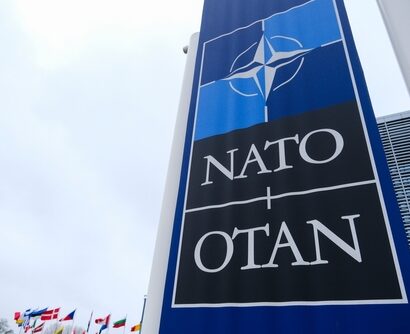Abstract: Andrej Duda’s offer to host in Poland US Troops that would have been withdrawn from Germany was widely seen as an attempt to curry favour from the then-contemporary Trump administration. However, when we view this offer dispassionately, we can see a strategic argument that basing US and other NATO forces in Poland makes strategic and operational sense despite the political optics. This paper argues that Duda was right to offer to host US troops.
Bottom-line-up-front: US forces based in western Germany are a legacy of a strategic context that has long since dissipated. By basing troops forward—i.e., in the areas they are likely to operate should the worst happen—NATO, the EU and wider Europe would be better served. Presently, most US and NATO forces in Europe are far removed from their potential theatres of conflict. Continuing to base in Germany comes with unnecessary strategic and tactical costs.
Problem statement: How to understand the benefits of the US military presence in Europe on the example of Poland?
So what?: This paper argues that NATO can be more strategically and tactically relevant by taking a forward-looking approach to force maintenance. Moving from Germany to Poland or the Baltics could enhance alliance security and offer an opportunity for the EU to work to heal its internal rifts.

Source: shutterstock.com/Klobuk
“Fort Trump” in Poland
Russian military activities on the Ukrainian border, combined with the announcement that the US would send another 500 troops to Germany; and the fact that Belarus will host part of Zapad-21, beg the question: Was there merit in Andrej Duda’s proposal to make Poland available to US troops who were withdrawn from Germany? Duda’s proposal was widely seen as both a confirmation of a rift between the US and Germany and an attempt by Poland to stroke the then US president’s ego by proposing to name a US base in Poland “Fort Trump.”[1] However, this proposal can also be viewed as a clever piece of political manoeuvring and a pragmatic strategic move. Moving US and NATO forces from Germany to Poland could benefit all stakeholders.
The Strategic Context Today
The United States military presence in Europe is a holdover from its occupation of Germany in the aftermath of the Second World War. From the late 1940s, the US occupation force, like that of the British Army of the Rhine (BAOR), transitioned from conquerors to allied partners with West Germany in response to the perception of a growing communist threat. This transition saw US forces based in southwestern Germany and the vicinity of the northern port city of Hamburg. These forces were deployed to defend West Germany and Western Europe from a Soviet assault through the Fulda Gap or across the Czech border.[2] Today, most US forces remain based in these locations—30 years after the key strategic rationale for their placement dissipated.[3] In 1958, Charles De Gaulle stated that NATO was an alliance that no longer corresponded to “political and strategic realities”, a statement that could be considered as true today as it was then.[4] One need only look at NATO’s struggles for relevance in the post-Cold War world. Out of area operations in regions of the world far removed from the ‘North Atlantic’ have become the organisation’s default as it seeks to maintain relevance. However, an invigorated Russia seems to be causing a refocus within the alliance to focus on security issues closer to home.
However, a brief look at US and NATO dispositions in Germany shows that eastern Germany is mainly devoid of US or NATO forces.[5] In western Germany, the opposite is true. In the event of an escalation or a fear of Russian invasion of western Europe, NATO forces deployed in Germany would have to undertake a long-distance road move from their bases and depots to meet a Russian threat somewhere in the Baltic or Poland. Given the size and nature of forces based in Germany, road movement would be the most efficient way disperse sizeable forces from base areas in the west to operational areas in the east.
In western Germany, the opposite is true. In the event of an escalation or a fear of Russian invasion of western Europe, NATO forces deployed in Germany would have to undertake a long-distance road move from their bases and depots to meet a Russian threat somewhere in the Baltic or Poland.
A reliance on road mobility becomes essential when considering that the weight of armoured vehicles has grown considerably since the Cold War. For example, the venerable M113 APC of Cold War vintage weighs 12.3 tonnes. Its direct successor, the Bae Systems AMPV, weighs approximately 36 Tonnes. Further to this, the Cold War-era M1 tank weighs 54 tonnes. Its current iteration, the M1A2 SepV3, weighs 66.76 tonnes[6]. The increased mass of vehicles is not exclusive to Armoured Fighting Vehicles. We can also see this in general service vehicles such as the ubiquitous Humvee M998A2, which weighs 4.68 tonnes, whereas its replacement, the JLTV, weighs 9.45 tonnes.[7] Whilst these are US vehicles, the problem of increased weight is not exclusively American; take the UK for example: at the outset of the Iraq war, the Land Rover Snatch 2 had a given weight of 3.05 tonnes, whereas its replacement, the Ocelot, weighs 7.5 tonnes.[8]
Enhancements in mobility such as Stryker brigades and light expeditionary forces may, to some degree mitigate the fact that troops are based far from the regions in which they are expected to operate. However, we must acknowledge that many heavily armoured formations are not as mobile nor as expeditionary as one may like. As noted above, modern equipment is growing in weight and size.[9] NATO troops will have to move considerable distances to unprepared positions to serve even as a signal of intent or resolve. Today, the situation contrasts with that of the Cold War when NATO forces were stationed near and intimately knew their deployment areas, which stocks were available, and how their support systems would function.
NATO troops will have to move considerable distances to unprepared positions to serve even as a signal of intent or resolve.
Today, having forces based long distances from operational areas pose two problems; a, there are increased logistics burdens through higher Petrol Oil Lubricant (POL) consumption caused by larger vehicles and longer distance to deployment areas; b, increased size and weight means forces are more challenging to move by air. The former can be alleviated pre-positioned stocks on likely avenues of march and by use of clever route planning. The latter, however, is more strident because of a dearth of strategic airlift in the alliance.[10]
The lack of strategic airlift in NATO can be seen in the fact that many member-states pool air transport through the Strategic Airlift Capability split amongst 10 NATO Allies and two partner nations. This programme is essentially a timeshare of pooled aircraft that consists of three C-17s.[11] Whilst these aircraft are capable, they have a maximum payload of 77.5 tonnes, which is sufficient to lift only one M1A2 SepV3.[12] Furthermore, in Europe, such aircraft lack in number and cannot carry certain size goods; thus, the alliance relies on outside actors. An example of this is the Strategic Airlift International Solution (SALIS). This additional programme can be used to provide civilian-owned Antonovs and Illuyshins for contingency operations.[13] However, it is unlikely such aircraft could be called upon in a crisis involving Russia.
Should the alliance be directly threatened along its borders, this would significantly strain the alliance; It would see a loss of initiative as NATO would be faced with the options of trading space—Poland/the Baltics/Eastern Partners—for time. NATO would have to sacrifice the Baltic states or Poland if we assumed that an assault might come through Belorussia or Kaliningrad; or allow a fait accompli like in Ukraine. Furthermore, whilst European states operate formidable air inventories, Russian A2AD capabilities in Kaliningrad—and potentially Belarus—may be capable of disrupting both air mobility and air superiority operations.[14]
It would see a loss of initiative as NATO would be faced with the options of trading space — Poland/the Baltics/Eastern Partners — for time. NATO would have to sacrifice the Baltic states or Poland if we assumed that an assault might come through Belorussia or Kaliningrad; or allow a fait accompli like in Ukraine.
Considering the return of a revanchist Russia, it makes little sense to have NATO/US forces based so far from their likely areas of operations. The fallacy of basing NATO and US troops in Germany becomes acute when considering the transport situation in both countries. Germany is endowed with a more extensive and more superior road and rail network than Poland.[15] Thus forward-basing troops in Poland would allow the totality of the German transport system to be utilised to offer enhanced logistical flexibility and contingency to any allied response. This logistical flexibility would be gained by stopping aggressing forces in Poland and thus limiting their ability to range into Germany or neighbouring states. Additionally, fighting in Poland would enable reinforcements to arrive in Bremen and Hamburg, thus reducing troop fatigue and vehicle wear caused by long-distance road marches from the Netherlands or France as has been practised in recent alliance manoeuvres such as Atlantic Resolve.
What is to be Done?
The need for a new mode of operation is implied by NATO’s Enhanced Forward Presence (eFP) concept. Here, NATO provides multinational battlegroups of around 1000 to 1500 troops to the three Baltic states and Poland. These forces stand as a signal of allied resolve and their commitment to these states. However, when considering troop numbers, eFP ranges from 4-6000 troops in total, whereas the US presence in Germany currently exceeds 34000.[16]
It seems axiomatic that the alliance should seek to move forces as far forward as is practical. Basing in Poland would allow the coalition to maintain a fully fleshed-out forward presence rather than the tokenistic form found in the eFP. Whilst one may see this as a potential escalation.[17]
Further to this, Russia has an ambiguous relationship with Belarus, wherein it may-or-may-not permanently base troops. And the same applies to nuclear weapons in Kaliningrad.[18] However, whilst there is no clarity on their permanent basing, Belarus is one of the locations for Zapad-21. The extensive quadrennial military exercises conducted by the Russians suggest deep ties between the states. Furthermore, elements of Zapad-21 being held in Belarus belies any idea that the exercise may be purely ‘defensive’ in nature. This could be achieved by examining Duda’s “Fort Trump” concept, in spirit if not in name. Basing forces in central or eastern Poland would ensure that troops were actually “forward-deployed” and thus diminish the need for a long road move at the outset of hostilities.
However, whilst there is no clarity on their permanent basing, Belarus is one of the locations for Zapad-21. The extensive quadrennial military exercises conducted by the Russians suggest deep ties between the states.
Furthermore, by being based in Poland rather than Germany, forces could be more easily rotated from the Baltic states to facilitate training and familiarisation, enhancing alliance solidarity. In addition, if troops were based in southern Poland, they would be closer to alliance members in the Balkans. This proximity could allow the smaller alliance members to feel more involved despite the current focus on the Baltic. In addition, being based in Poland would enable allied forces to hold a line much further forward than would generally be possible. This would undoubtedly ease allied logistic burdens and reduce the need to disembark troops in northern France, as was seen with the recent Exercise Atlantic Resolve.[19]
Southern Poland may be ideal as it allows the alliance to break new ground in a symbolically significant manner. This location is ideal as all NATO forces in Poland are currently based on the German border or near the border with Kaliningrad. Placing troops in the southeast would enable NATO to have forces in the east, but not built-up on the border with Kaliningrad. This latter point could help neuter Russian opposition. Additionally, as recent history shows, Ukraine is under the most direct and persistent threat; thus, friendly forces nearby would send reassuring signals. Although not a member of either the EU or NATO, it is a country that seeks deeper ties with the west. Because of this, it makes sense to have forces based as near as possible should the situation decline significantly. In addition, forces based in south-eastern Poland could also reassure the three neighbouring Visegrad states.
Whilst such actions might be considered threatening to the Russians, one must consider what ‘threatening’ means in this context. The Russian use of ‘fear’ has become a trope in Putin-era Russia, and by accepting such an argument, western powers cede the initiative to the Russians. Russia must accept that Poland, the Baltics, and Ukraine are sovereign states, and they have the right to host partner-nations in the same way CSTO nations and Belarus do. Western political divisions and a reluctance to seriously hold Russia to account have emboldened Russian security forces to conduct a spate of murders across Europe since 2006.[20] As such, worrying about how Russia might feel in light of its intransigence of the last decade seems naïve.
The Russian use of ‘fear’ has become a trope in Putin-era Russia, and by accepting such an argument, western powers cede the initiative to the Russians.
Who Would Benefit?
Depending on how the relocation of forces unfurled, benefits could be shared across all countries involved. There is no reason for such a change to be zero-sum. Suppose Germany were to acquiesce to the relocation of US forces to Poland amiably. This could be used to mend the fence between the two states as it would provide ample proof to the Polish public and political class that Germany remains a friend despite their differences. Furthermore, Germany would not have to lose all of its US or NATO units as Germany could serve as a logistic/training hub for forces in Europe.
Furthermore, Germany’s role within the alliance could change to a reception, staging and onward movement (RSOM) base for follow-on forces from the U.S./Western Europe.[21] This makes sense considering the excellent infrastructure in place and in light of the recently established Joint Support Enabling Command (JSEC), which will come online in September 2021—interestingly, this newly created capability is also based in Western Germany, in the city of Ulm.[22]
However, we must emphasise that the existence of this infrastructure is no reason to permanently keep 30,000+ troops in Germany—this is merely sunk cost at work. This is especially true as the original strategic rationale for keeping troops in Germany no longer exists— as evidenced by the drawdown of UK forces from the country.
The EU could also gain in terms of goodwill and practical security enhancement. The former could be achieved by using Structural Funds to help improve infrastructure in whatever location would be chosen—this could be based on a combination of strategic and economic need—as the new home for forces stationed in Poland. This would naturally have to include improvements to logistical infrastructure such as roads, railways, and airports, not to mention communications infrastructure. In an echo of the US Interstate programme, improving logistics and communications infrastructure for military reasons can contribute to the regional economy. In terms of security, the EU would benefit by providing tangible signs that it supports the protection of Poland and the eastern flank of Europe. However, the problem may be finding the political will within the EU for such a change.
In an echo of the US Interstate programme, improving logistics and communications infrastructure for military reasons can contribute to the regional economy.
What are the Costs?
Naturally, moving thousands of troops from a long-established garrison to one that is at present non-existent would incur significant financial, political, and operational costs—not to mention social costs. However, given the multinational nature of the alliance and the stated purpose for being, it is not beyond reason that solutions for these problems could be found.
From a financial perspective, the Polish state has intimated that it was willing to pay some of the cost of relocation; whether this rings true in the Biden era remains to be seen.[23] The EU could also financially support the move; as mentioned earlier, it could help reduce infrastructure costs. These funds could be received from the EU Structural Funds. Perhaps the EU Defence Fund could also help pay for the move as reinforcement of the eastern flank of the Union is a pressing defence matter for states in the region.[24]
Politically, things become less clear as there may not be a will to remove troops from Germany since Trump is no longer in power. However, should US planners see fit to move forces forward, it is unlikely that any Polish government will refuse to host them.
If such a move were to occur, German feelings must be considered. While there may be a desire in some portions of German society to see US troops leave. According to a YouGov poll conducted in August 2020, many Germans indicated that 47 per cent of Germans favoured reducing the number of US soldiers from 36,000; additionally, a quarter of respondents believed that US forces should be withdrawn entirely from Germany.[25] We can infer from this that relocation of US forces would be unproblematic to the average German.
Beyond German sentiment, we must consider alliance unity. While the United States could take a bilateral decision to move its forces to Poland, it would be better if such a US permanent presence was conceived as part of NATO’s overall posture. After all, the power of NATO relies not on troops in the field but on the message the alliance as a unified actor sends.[26] Thus, the overarching concern is to preserve NATO unity. As such, German approval and EU support could significantly enhance such a project.
Operationally, moving forces forward will cause friction for troops based in Germany. Many practical aspects—ranging from the housing of troops to exercising them adequately for their mission—must be addressed. Additionally, a Status of Forces Agreement (SOFA) would need to be ironed out before any permanent deployment can occur. However, whilst moving large numbers of forces from one country to another may seem to be quite a hurdle; we must remember, there is a historical precedent in the so-called ‘Big Move’, which took place after France expelled SHAPE from French territory in the 1960s.[27]
Socially, moving troops from one state to another may incur some local dissent in the sense that the troops are not returning to their home country but instead to a neighbour. However, as US troops are maintained in only a few areas of Germany, the social impact of their removal should not carry a significant impact; this is especially true when troops are located in the wealthier western part of the state.
Conclusion
Was Duda right to offer Poland as a base for US troops? Considering the political and strategic situation in Europe, yes, of course. US and NATO forces should be relocated from Germany. But this should be part of a considered strategy to enhance Euro-Atlantic solidarity and security; not as an ego-stroking act of vainglory. Any move should be conceived as the Polish Ministry of Defence put it: “to ensure the security of Poland and the entire eastern flank of NATO”.[28] NATO should seek to move forces closer to the areas in which they may be expected to operate—a practice long undertaken in the cold war.[29] Deploying forces sensibly will give additional strategic depth and greater logistical flexibility to the alliance. It would also allow both the EU and its Member States to make a concrete contribution to their own security in coordination with their counterparts in NATO. Having considered these strategic perspectives, we can say that despite the rhetoric, Andrej Duda was right to offer the use of Poland to the US.
Deploying forces sensibly will give additional strategic depth and greater logistical flexibility to the alliance. It would also allow both the EU and its Member States to make a concrete contribution to their own security in coordination with their counterparts in NATO.
Dermot Nolan has spent 12 years in the Army Reserve in Ireland, where he served in the Artillery Corps. He holds a master’s degree in Military History and Strategic Studies from the National University of Ireland at Maynooth. In addition, he has a master’s degree in International Relations and International Security from the Rijksuniversiteit Groningen in the Netherlands. His key interests are modern land war, airpower, and nuclear deterrence. His work has been published in European Security and by Finabel-The European Army Interoperability Centre.
[1] Michal Baranowski, ‘The Biden Administration: Opportunity or Stress for German-Polish Relations?’ The George Marshall Fund. Blog post (21 January 2021) Available at: https://www.gmfus.org/blog/2021/01/21/biden-administration-opportunity-or-stress-german-polish-relations [Accessed 18 June 2021]; See also: Piotr Buras, and Josef Janning, Divided at the centre: Germany, Poland, and the troubles of the Trump era, ECFR Policy Brief (19 December 2018). Available at: https://ecfr.eu/publication/divided_at_the_centre_germany_poland_and_the_troubles_of_the_trump_era/ [Accessed 18 June 2021].
[2] David Miller, The Cold War, A Military History (London; 2001), pp.241-243.
[3] Todd W. Fields, ‘Eastward Bound, The Strategy and Politics of Repositioning U.S. Military Bases in Europe. Journal of Public and International Affairs, Volume 15/Spring 2004, for a detailed analysis of the deployment of US military power in Germany, see Donald A. Carter, Forging the shield: the U.S. Army in Europe, 1951-1962, Center of Military History United States Army, (Washington, D.C., 2015) pp.7-12.
[4] Charles De Gaulle, q.i Timothy A Sayle, Enduring Alliance: A History of NATO and the Postwar Global Order: (Cornell University Press, 2019),50.
[5] United States Army, ‘U.S. Army Europe and Africa Garrisons’ Army.mil. Available at: https://www.europeafrica.army.mil/Garrisons/ [Accessed 23 June 2021].
[6] For examples of the weights of various systems mentioned see: https://www.army-technology.com/projects/bae-systems-armoured-multi-purpose-vehicle/; and https://man.fas.org/dod-101/sys/land/m1.htm and, https://asc.army.mil/web/portfolio-item/gcs-m1-abrams-main-battle-tank/ and for further analysis https://www.defensenews.com/land/2021/01/26/creeping-weight-of-abrams-tank-concerns-pentagons-chief-weapons-tester/.
[7] For weights of Humvee and JLTV see https://www.army-technology.com/projects/hmmvv/ and https://mwi.usma.edu/stuck-in-the-sand-why-the-joint-light-tactical-vehicle-is-ill-equipped-for-tomorrows-battlefield/.
[8] For comparisons of Land Rover Snatch and Ocelot LPPV see https://www.army-technology.com/projects/ocelot-lppv/ and http://www.armedforces.co.uk/army/listings/l0152.html.
[9] For descriptions of the issues facing the alliance in reinforcing Europe see David Larter, Military Sealift Command in Europe Enables DEFENDER-Europe 21′, (17 May 2021) Defense News. Available at: https://www.defensenews.com/naval/2018/10/08/the-army-is-preparing-to-fight-in-europe-but-can-it-even-get-there/ [Accessed 31 August] see also, Jen Judson, Deterring Russia: US Army hones skills to mass equipment, troops in Europe, (17 March 2017) Defense News. Available at: https://www.defensenews.com/digital-show-dailies/global-force-symposium/2017/03/17/deterring-russia-us-army-hones-skills-to-mass-equipment-troops-in-europe/ [Accessed 31 August].
[10] A lack of European Air Lift is a long-standing problem, see Major Lee Hages, Europe’s Strategic Airlift Gap Quantifying the Capability Gap and Measuring Solutions, Journal of the Joint Air Power Competence Centre, (Autumn/Winter 2014). Available at: https://www.japcc.org/europes-strategic-airlift-gap/ [Accessed 02 August 2021]. Here Major Hages discusses the impacts of the European lack of Air Lift for crisis response. Interestingly, Major Hages does not discuss the military ramifications of such a lack of platforms.
[11] For information on the SAC see https://www.sacprogram.org/en/Pages/The%20Strategic%20Airlift%20Capability.aspx [Accessed 29 August].
[12] For information on the capabilities of the C17 see https://www.af.mil/About-Us/Fact-Sheets/Display/Article/1529726/c-17-globemaster-iii/ [Accessed 29 August].
[13] For details on the SALIS program see https://www.sacprogram.org/en/Pages/The%20Strategic%20Airlift%20Capability.aspx [Accessed 29 August]. for additional analysis of the benefits of this program see: https://www.nspa.nato.int/news/2020/SALIS-Key-capability-covid-19 [Accessed 29 August].
[14] Keir Giles & Mathieu Boulegue, “Russia’s A2/AD Capabilities: Real and Imagined,” Parameters 49, no. 1 (2019). Available at: https://press.armywarcollege.edu/parameters/vol49/iss1/4 [Accessed 15 August 2021] p.26-27. For NATO concerns about the growing closeness between Belarus and Russia see: ‘Russian Military Build-up and Crisis in Belarus at the Center of Polish Strategic Concerns’ NATO Parliamentary Assembly (14 April 2021). Available at: https://www.nato-pa.int/news/russian-military-build-and-crisis-belarus-center-polish-strategic-concerns [Accessed 17 August 2021].
[15] Eurostat, ‘Inland transport infrastructure at regional level’, May 2021. Available at: https://ec.europa.eu/eurostat/statistics-explained/index.php?title=Inland_transport_infrastructure_at_regional_level#The_densest_motorway_networks_are_located_around_key_economic_hubs [Accessed 20 July 2021]. This report is particularly glowing about German road infrastructure:” High motorway densities are also found around the major seaports of northern Europe: the motorway densities of the regions of Bremen (205 km per 1000 km2) with the port of Bremerhaven, […]and of Hamburg (114 km per 1000 km2) are among the highest of all European regions”. It further states “Another reason for the high density of the motorway network in some central European countries (such as Germany) is the proportionately high volume of transit freight traffic”.
[16] eFP troop sizes were given as 4615 personnel as of February 2021, see: NATO, NATO’s Enhanced Forward Presence, Fact Sheet: (February 2021). Available at: https://shape.nato.int/resources/site16187/General/factsheets/factsheet_efp_2021.pdf [Accessed 25 July 2021].
[17] For information on the CSTO see https://en.odkb-csto.org and for some insight into its weaknesses see Dmitry Gorenburg, Russia and Collective Security: Why CSTO Is No Match for Warsaw Pact, Russia Matters (May 27, 2020) Available at: https://www.russiamatters.org/analysis/russia-and-collective-security-why-csto-no-match-warsaw-pact [Accessed 01 September 2021].
[18] Whilst Russia professed to keep Kaliningrad nuclear-free it does maintain nuclear weapons storage and nuclear-capable missiles within the enclave. As a result, we must consider any Russian guarantees that the enclave is nuclear-free to be unreliable. See: Rose Gottemoeller, Russia Is Updating Their Nuclear Weapons: What Does That Mean for the Rest of Us? Carnegie Endowment for Peace (JANUARY 29, 2020). Available at: https://carnegieendowment.org/2020/01/29/russia-is-updating-their-nuclear-weapons-what-does-that-mean-for-rest-of-us-pub-80895[Accessed 25 August 2021]. And: Hans Kristensen, Russia Upgrades Nuclear Weapons Storage Site In Kaliningrad, Federation of American Scientists (18 June 201180. Available at: https://fas.org/blogs/security/2018/06/kaliningrad/ [Accessed 25 August 2021].
[19] Staff Sgt. Benjamin Northcutt, ‘1 ID CAB arrives in Dunkirk, France for Atlantic Resolve’: March 8, 2021. Available at: https://www.army.mil/article/244047/1_id_cab_arrives_in_dunkirk_france_for_atlantic_resolve [Accessed 17 June].
[20] Doug Klain, ‘Russian assassinations send chilling message of impunity’, Ukraine Alert, The Atlantic Council (12 March 2020) Available at: https://www.atlanticcouncil.org/blogs/ukrainealert/russian-assassinations-send-chilling-message-of-impunity/ [Accessed 21 June 2021].
[21] Eva Hagström Frisell (ed.) Deterrence by Reinforcement. The Strengths and Weaknesses of NATO’s Evolving Defence Strategy, (Swedish Defence Research Agency, 2019), .11-13. Available at: https://www.foi.se/rest-api/report/FOI-R–4843–SE [Accessed 12 August 2021].
[22] For more information see: https://jsec.nato.int/
[23] Ministry of National Defence (Poland), ‘The foundation of Fort Trump is an investment in our security’ Government of Poland, 30 October 2018. Available at: https://www.gov.pl/web/national-defence/the-foundation-of-fort-trump-is-an-investment-in-our-security [accessed 19 June 2021].
[24] Rick Fawn (ed.), Managing Security Threats along the EU’s Eastern Flanks,(Palgrave McMillan:2020),15-26.
[25] Kristie Pladson, Nearly half of Germans in favor of US military withdrawal: survey, Deutsch Welle (04 August 2020). Available at: https://www.dw.com/en/nearly-half-of-germans-in-favor-of-us-military-withdrawal-survey/a-54427490 [Accessed 21 August 2021] see also: James Kirchick ‘You wouldn’t know it from the coverage, but most Germans are fine with Trump’s withdrawal of US troops’, Brookings, August 11, 2020 https://www.brookings.edu/blog/order-from-chaos/2020/08/11/you-wouldnt-know-it-from-the-coverage-but-most-germans-are-fine-with-trumps-withdrawal-of-us-troops/ [Accessed 21 August 2021].
[26] Quentin Lopinet, ‘Fort Trump?’—Is There Added Value to a Permanent U.S. Military Base in Poland? CSIS, (November 19, 2018 ). Available at: https://www.csis.org/analysis/fort-trump%E2%80%94-there-added-value-permanent-us-military-base-poland [Accessed 12 August 2021].
[27] Francois Le Blevennec, ‘The big move’ NATO Review, (Summer 2007). Available at: https://www.nato.int/docu/review/2007/issue2/english/history.html [Accessed 16 June 2021].
[28] Ministry of National Defence (Poland), ‘The foundation of Fort Trump is an investment in our security’ Government of Poland,( October 30 2018). Available at: https://www.gov.pl/web/national-defence/the-foundation-of-fort-trump-is-an-investment-in-our-security [Accessed 19 June].
[29] G. Thomas, P. Williams, Y. Dyakova, ‘Exercise Defender-Europe 20: enablement and resilience in action’, NATO Review (16 June 2020) Available at: https://www.nato.int/docu/review/articles/2020/06/16/exercise-defender-europe-20-enablement-and-resilience-in-action/index.html [Accessed 21 August 2021], See also: Mario Blokken et al, ‘Training and Simulation’, Finabel Food For Thought, (Finabel-The European Army Interoperability Centre, Brussels: 2021), 5-9. Available online: https://finabel.org/wp-content/uploads/2021/05/Training-and-Simulation-Publication-Version.pdf [Accessed 12 June 2021]. For a Cold War perspective, see: David Miller, The Cold War, A Military History, (London: Pimlico 2001), 359-362.





